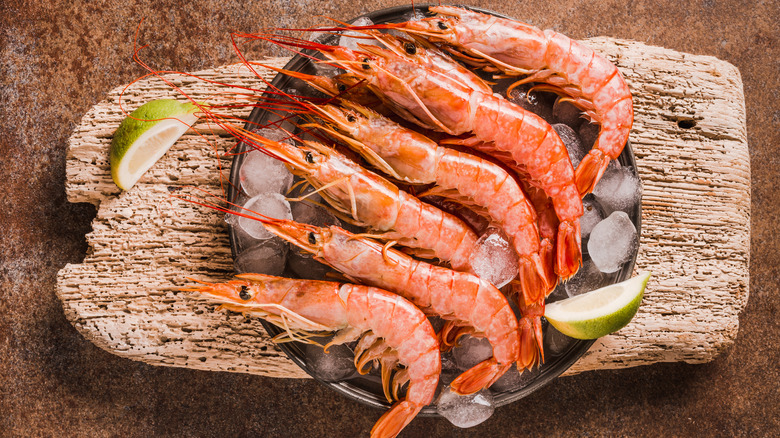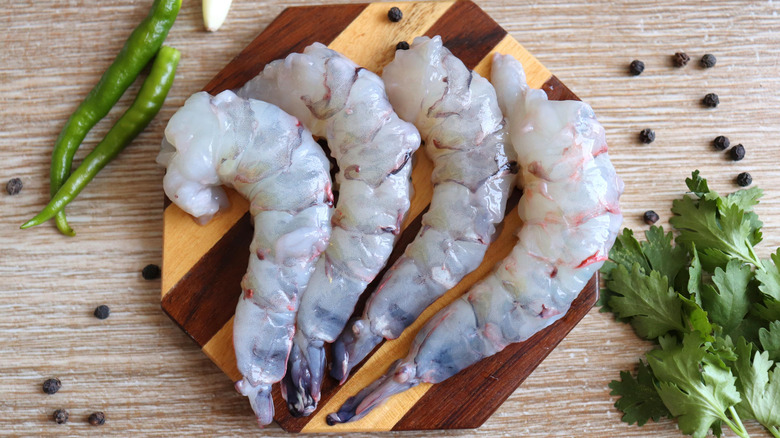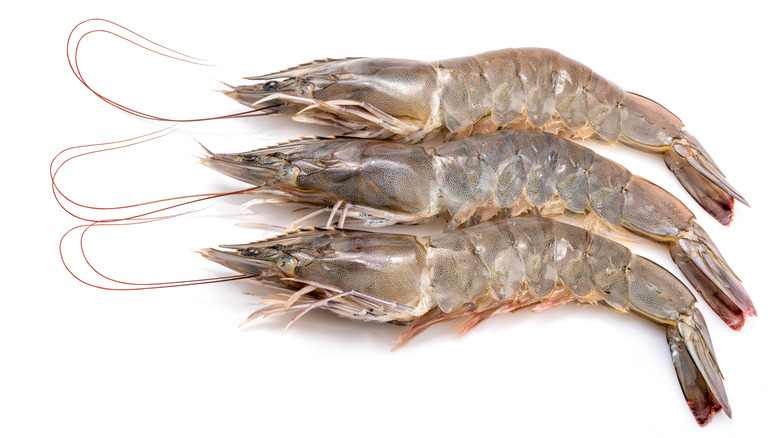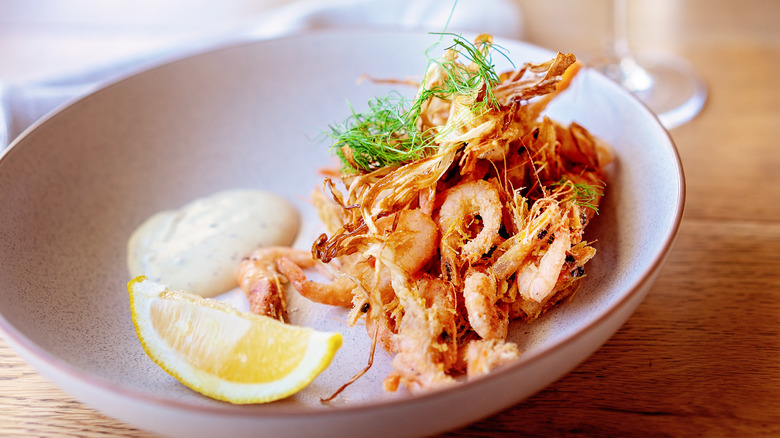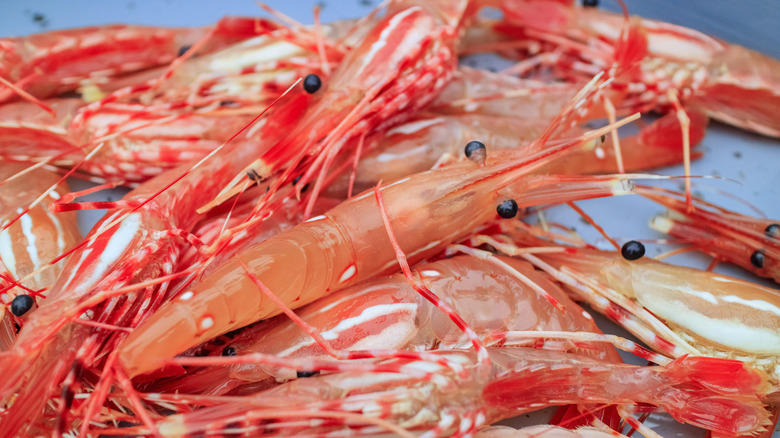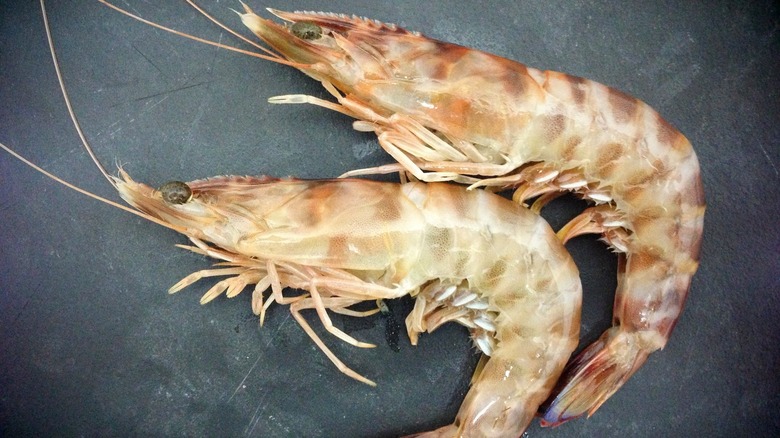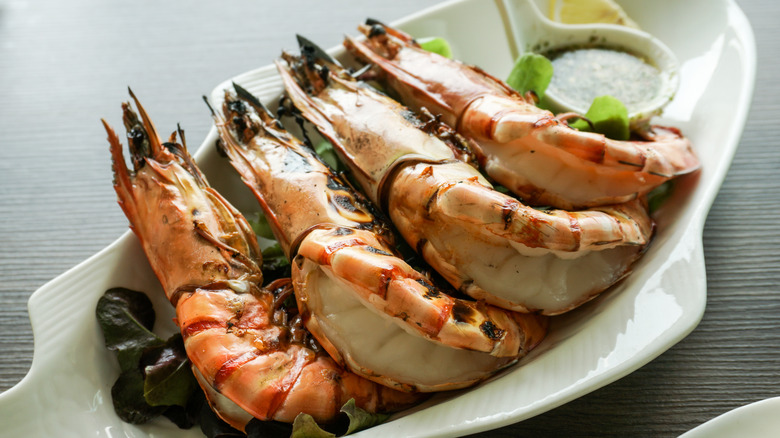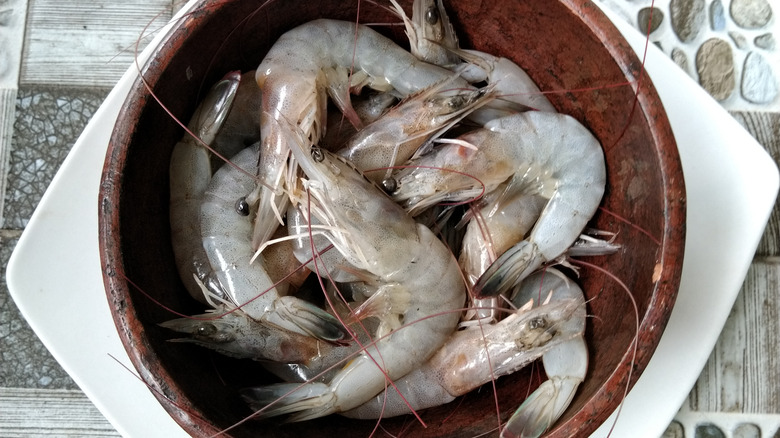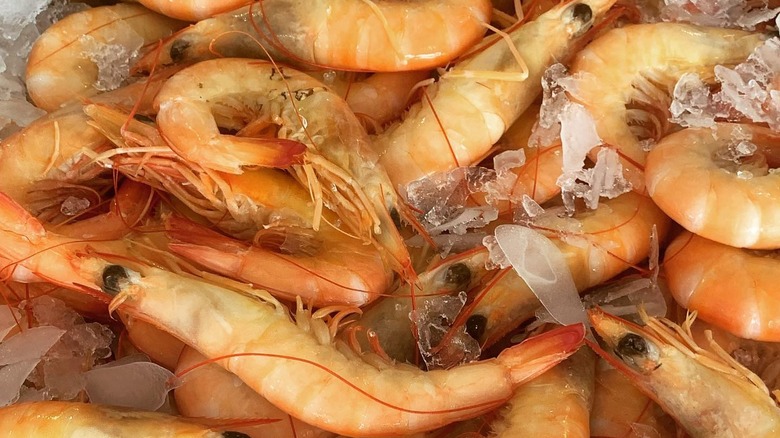8 Types Of Prawns And How To Eat Them
Poach 'em, grill 'em, pan-fry 'em, or cook 'em as tempura, there's a reason why the humble prawn is such a well-loved crustacean globally. As per IMARC, a leading market research company, the international prawn market is estimated to reach a whopping 9.89 million tons by 2026.
Besides the fact that this buttery, melt-in-the-mouth seafood is incredibly delicious, it is also packed with antioxidants, vitamins, and essential trace minerals, per BBC Good Food. When you think of prawns, chances are your mind immediately conjures an image of pink-hued crustaceans served at a fancy restaurant. However, prawns aren't just a gourmet's dream. They are complex aquatic animals with a myriad of species, each with unique characteristics and flavor profiles.
If you are a fan of prawns, you should familiarize yourself with the types you usually eat — and learn about new ones to taste. We'll examine the best species of prawns eaten worldwide, as well as an array of tips on how you can prepare them all.
1. Giant Tiger Prawn
If you have seen a black-bodied crustacean with orange stripes and a baffling size, chances are you encountered the giant tiger prawn. These sea beasts can grow up to a foot and weigh up to a pound at their fullest (via Texas Invasive Species Institute). However, they are not among the most favorite marine species due to their predatory nature.
As Texas Invasive Species Institute notes, the conservation of giant tiger prawns is of least concern. These marine predators are voracious omnivores that prey on smaller prawns. Moreover, they also carry 16 types of diseases that can harm entire prawn populations. So the next time you find them on a menu, be sure to devour them because it will encourage fishmongers to catch more giant tiger prawns.
Connoisseurs don't generally prefer farmed species, which happen to be considerably cheaper than marine species. However, their aversion doesn't depend on the price tag but on the considerable taste difference between the two. According to Seafood Source, farmed tiger prawn has a subtler flavor, whereas marine species carry a briny seafood taste, hence the discrimination.
Try your hand at a surf and turf recipe and combine tiger prawns with ribeye steak, which gets an extra oomph with garlic confit and vanilla butter. Make sure to finish everything on your plate because you'll be doing a favor to other marine prawns.
2. Banana Prawn
Shaped like the fruit of the same name, banana prawns are much sweeter than other prawn species. Scientifically known as fenneropenaeus indicus, the creatures weigh anywhere from just under 1 ounce to close to 3 ounces and measure between 14 cm and 25 cm long (via Sydney Fish Market).
As per the Australian Fisheries Management Authority, banana prawns come in two varieties: white-legged and red-legged. They are a major commercial prawn species due to their extensive breeding. In fact, one female prawn lays 100,000 to 450,000 eggs in one go. And since there are a lot of female prawns in the ocean, there are tons caught with bottom trawls.
In the culinary world, Australian Tropical Foods notes that these prawns are mostly used in curries and hot dishes rather than cold platters. Barbecued or lightly fried, banana prawns taste exceptional when coupled with some spices for an extra kick.
3. School Prawn
Native to Australian waters, school prawns (scientifically known as Metapenaeus macleayi) are a must-try variety of prawns (via Australian Fish Stocks Reports). Although the scientific name is quite a tongue twister, their common name is associated with groups of them. Besides being called school prawns, Sydney Fish Market notes that depending on where they are caught, these aquatic animals are also called NSW school prawn (from New South Wales, Australia), Stockton bright prawn, York prawn, White River prawn, Bay Prawn, schoolie, and river prawns.
In terms of flavor, Sea-Ex notes that school prawns are generally sweeter than other prawn types so you should avoid cooking them with strong spices to let the taste stand out. Barbecued, pan-fried, or deep-fried — either way, you'll be licking them off your plate. You can eat this delicious seafood with or without shells depending on the level of crispiness you prefer.
In their raw form, these crustaceans have a distinctive olive green color which changes to white flesh with pink stripes once cooked. If you're buying pre-cooked school prawns, make sure not to cook them too long, or else you will end up with a chewy rubbery disaster.
4. Spot Prawn
Large translucent pinkish-orange spot prawns have a distinctive horn on their head that sets them apart. Additionally, these sea beauties have two white spots on their exoskeleton that for obvious reasons, earned them their name. BC Live Spot Prawn notes that you can find this buttery, melt-in-your-mouth delicacy in sustainable fisheries from May to early July. Interestingly, the website recommends buying spot prawns with their heads still on. This is because as soon as you behead them, an enzyme is released in their bodies producing black spots (a tell-tale sign of rotting).
You'll be glad to learn that there's no threat to the seabed nor excessive bycatch thanks to the work of many sustainable fisheries in harvesting the species. The commercial traps have a special design that doesn't catch smaller prawns, and there are restrictions regarding the mesh size to conserve the species (via BC Spot Prawns).
According to the most prominent sustainability advocate of British Columbia spot prawns, chef Robert Clark, minimum seasonings will work the best for this treat from the sea. He suggests simply pan-searing them in butter, garlic, parsley, and white wine to really bring out their outstanding flavor.
5. Caramote Prawn
Smaller relatives of the giant tiger prawns, caramote prawns (also known as imperial prawns) are characterized by their reddish-brown stripes and translucent bodies. As per Gruppo Azione Costiera, the species is native to the Mediterranean Sea. These prawns are around 12 cm long and primarily feed on mollusks and other small crustaceans. They tend to live on muddy seabeds that most fishmongers stir with their trawl nets.
Since caramote prawns are one of the most overfished aquatic species, WWF Seafood Guide discourages buying these little crustaceans during their spawning period from June to October. Due to their delicate flavor, caramote prawns are a highly sought-after species worldwide. Like pretty much all types of prawns, caramotes taste delicious when grilled, pan-seared, or cooked in a spicy curry. Perhaps the best way to fully appreciate these delectable crustaceans is to sear them over a live flame for a minute on each side.
6. Kuruma Prawn
What do you call a tiger prawn if you buy it in Japan? A Japanese kuruma prawn. That's a stretch, since even though the two look similar in appearance, they are in fact two different prawn species. According to the Invasive Species Compendium, they have three elements in common: a big size, striped exoskeleton, and the ability to reproduce (700,000 eggs from a single spawning female). Still, this is not a case of aquatic migration. The kuruma prawn, scientifically named Marsupenaeus japonicus, is the only species in the genus Marsupenaeus that you can find from Fiji to the Mediterranean Sea.
As per Global Seafood Alliance, kuruma prawns are deemed to be the King of Marine Foods in Japan and consequently, tend to be expensive. Dr. Leslie Tay, food consultant and author, makes an interesting observation that these giant striped prawns get their name from the female's reproductive organ, which resembles the pouch of a kangaroo (marsupials). It is the female kuruma reproductive organ that actually differentiates it from giant tiger prawns.
Moving forward from the anatomy to the culinary uses, kuruma prawns are an undisputed choice for tempura in Japanese restaurants. Raw kuruma prawns are generally translucent. However, once cooked, they turn a stunning shade of red. Given their sweet taste and firm texture, they are best served raw or broiled. If you plan on eating them raw, make sure you rinse them in water and peel them once defrosted.
7. Eastern King Prawn
If you're planning to clean and devein this variety yourself, get ready for a pierced finger because these kings come with swords. According to the Australian Museum, Eastern king prawns have a spike on their heads that guards them against predators (that includes humans too). These prawns are native to Australian waters and are typically found both in the ocean and estuaries in the areas of Queensland, New South Wales, Victoria, and Tasmania. They have transparent bodies with a blue-tinged tail with red edges.
Sea-Ex notes that the young Eastern king prawns usually stay in the estuaries where they are harvested. The male and female prawns differ in weight and length, and unlike humans, females take the lead in almost all the prawn species, including this one. The males can grow up to 19 cm and the females can attain 30 cm. The weight of female Eastern king prawns can reach close to 8 ounces, whereas the males weigh almost half.
With a rich flavor and moist texture, Fish Files suggests butterflying the prawns and grilling them until the shell gets crunchy. Pair them with chimichurri sauce and get the most out of their succulent flesh.
8. Endeavour Prawn
Before you devour prawns, there are a few steps to take — especially if you plan to clean and devein them at home. The case remains pertinent to Aussie endeavour prawns too. Their habitat tends to be in the waters of Western Australia when they are young. The fisheries in these areas ensure sustainable fishing practices that don't harm the sea floor or the aquatic bycatch species (via Good Fish).
When it comes to endeavour prawns, there are two major types: blue and red. However, these aren't the colors of their entire bodies, but only of the edge of their tails. Both species have different body lengths and weights. According to Sydney Fish Market, the blue species can be 7 to 14 cm in length and weigh more or less 1 ounce. The red variety, on the other hand, is a bit smaller.
The endeavour prawns website defines the flavor of this commercial species as "stronger than regular prawns." Since these moderately sweet-tasting prawns are so incredibly versatile, you can pair them up with other prawn species as well. Eat them as finger food drenched in chili or soy sauce, or batter them for a tempura recipe. Endeavour prawns are also a popular choice for prawn salad and chilled seafood platters.
